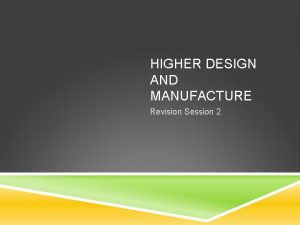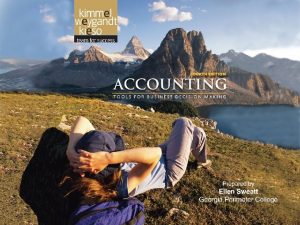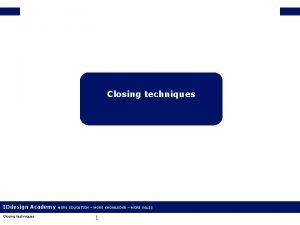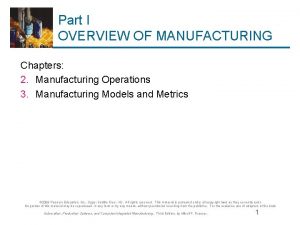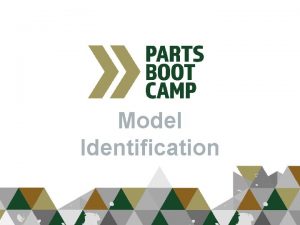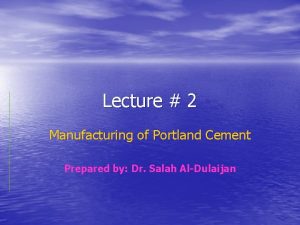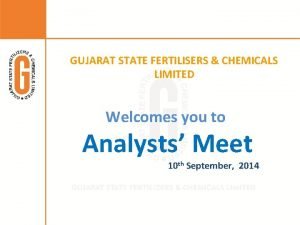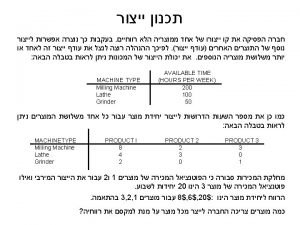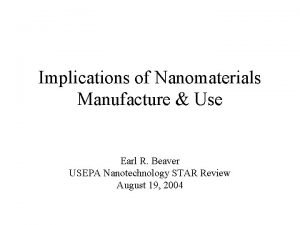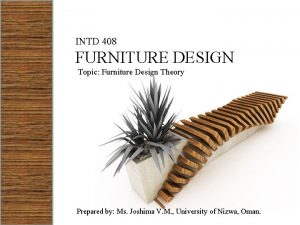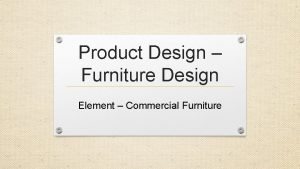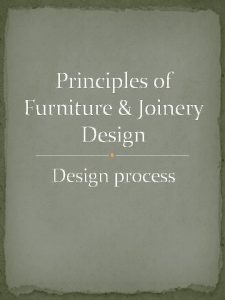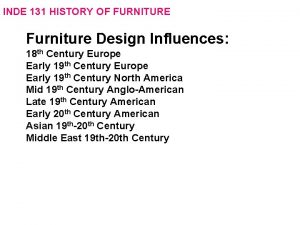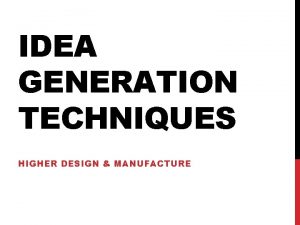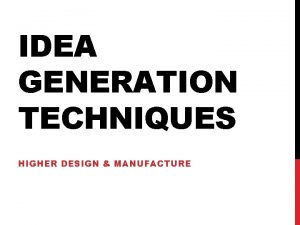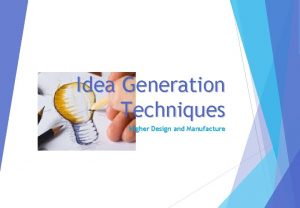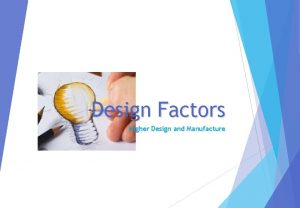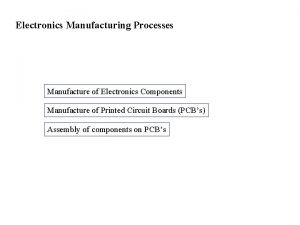RESEARCH TECHNIQUES Furniture Design Unit Higher Design Manufacture











- Slides: 11

RESEARCH TECHNIQUES Furniture Design Unit Higher Design & Manufacture

CARRYING OUT RESEARCH There are 2 different sources of information: Recorded & Non Recorded Information

RECORDED INFORMATION This is information that has been previously prepared or compiled, usually in written form. Obtaining the info from these sources is called ‘Desktop Research’ Recorded info can come from: Textbooks Product Instructions or Marketing info Magazine or Newspaper Reviews of products Academic or Industry journals Websites

Textbooks: These are good for tables & lists of information and for descriptions of how and why things are done. Product Instructions or Marketing info: These are good for researching the CAPABILITIES of a product. Magazine or Newspaper Reviews of products: These are good for comparison of products or opinions on a product. (However the info can often be subjective). Academic or Industry journals: Good for specific information on the latest products or industrial developments. (The info provided should be objective). Websites: These can provide almost any info and may be an electronic version of any of the above info sources. You have to be careful of the websites you use as some of them may be biased, or untrue.

REMEMBER… Desk research may not always provide the most up-todate information. The fact that the source has already been published may mean that current trends or new competition to the product have not been taken into account. However, it may well provide general information about consumers and competitors.

NON-RECORDED INFORMATION Non Recorded information is info that has not been previously prepared. Obtaining the info from these sources is called ‘Field Research’. Non recorded info can come from: Tests or Simulations Personal opinions Capabilities of Target Market

Tests or simulations: These are carried out on products, models or prototypes. You are likely to use this throughout the design process to test out your design ideas. See next slide Personal Opinions: These are collated from the target market through interviews or questionnaires. You may use this method of research to help develop or justify your deign issues. Capabilities of target market: This is obtained through observation of a product being used by a member of the target market.

PRODUCT TESTING End user trials These require end users (or people pretending to be end-users) to actually use a similar product to the one in which you will develop. Such experiments should include the sorts of activities that might be undertaken immediately before and after the products have been used. These can generate a number of improvements and changes that designers and manufacturers might not otherwise consider. User Research This may involve watching experienced and inexperienced users. They should be observed closely so that improvements and further developments to the product may be identified. Such observation can be followed up with questionnaires and discussion on how users feel about the product. Concept testing This requires a new product to be tested on small groups of consu, mers who are part of that products target market group. This may not always require a prototype of the product. Models, pictures or even just a description of the proposed product may be enough to establish if the idea has market potential.

Research is vital to the success of every designer’s work. Sourcing relevant information, collecting materials, identifying the important data and then using it can be a time consuming activity. However, it is a necessary activity if the product is to succeed in today’s highly competitive marketplace. Asking questions will feature prominently in all types of research work. There is a skill to asking questions, and asking the right type of questions of the right people is a key feature to collecting relevant data

Essentially there are 4 different types of questions that can be asked. Closed questions These usually result in a yes or no type of answer being given. Although this is useful, this type of question usually leads to the least amount of information being given Open Question This type of question is designed to encourage people to give their opinion or point of view. Open questions can be very difficult questions to ask and should be phrased carefully to avoid the risk of influencing any answer that may be given. Ratings Question This type can also help people express an opinion and is quicker and easier method than the open minded question. People are normally asked to give a rating using a pre determined scale of say 1 to 10. Structured Questions These are very useful particularly if answers may not be straightforward or a lot of information is required about something. It will prevent people going off at a tangent and giving long winded answers which are not necessary.

RESEARCH EACH DESIGN ISSUE & PRESENT YOUR FINDINGS Research can be carried out at ANY TIME in the design process. It should not be restricted between the brief & the specification. Ensure the research carried out will lead to a detailed SPECIFICATION. The information gathered MUST be relevant to the brief e. g. bathroom storage unit and not be general information. You should show that you have used the research findings by making reference to it through annotation, throughout the development of your design ideas and when justifying choices.
 Higher design and manufacture
Higher design and manufacture Incremental analysis formula
Incremental analysis formula Furniture sales closing techniques
Furniture sales closing techniques Manufacture vs production
Manufacture vs production Yale forklift year by serial number
Yale forklift year by serial number Manufacture of portland cement
Manufacture of portland cement Ultimate analysis formula
Ultimate analysis formula Terylene nylon cotton polyester
Terylene nylon cotton polyester Ocr engineering manufacture
Ocr engineering manufacture Chemical manufacture
Chemical manufacture A firm is planning to manufacture a new product
A firm is planning to manufacture a new product Manufacture
Manufacture
